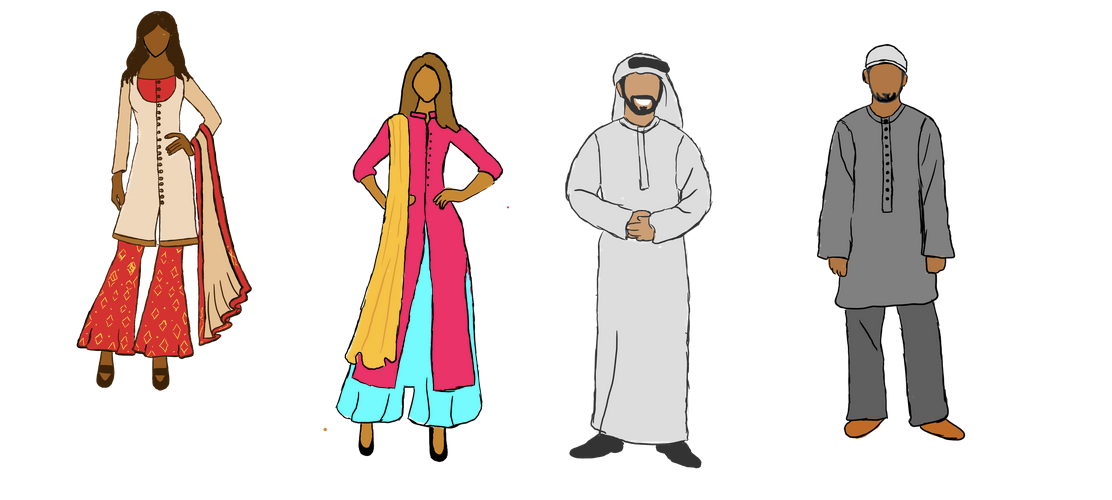The intertwining of faith and fashion
April, 2022
Graphic: Lydia Madamopoulou
Fashion has always played a huge role in Muslim culture and identity. Most Muslims opt for modest fashion, which is designed to keep our bodies concealed and safe from unwanted gaze. Though there may be restrictions to keep clothing aligned with Islamic principles, they put no restriction on creativity. Muslims around the world use their own creativity and individuality to rock an outfit that keeps them covered up and fashionable.
An important topic of conversation when it comes to Islamic fashion is the incorporation of the hijab, a type of veil which covers the head, hair, and neck, but not the face. Much like the Muslim women that wear it, the hijab comes in many varieties that tend to be shaped by place, time, and current trends. Wearing a head covering is one of the most visible symbols of Islam in the West, and it is quite often the most misunderstood. There is huge controversy surrounding the idea of Muslim women wearing the hijab, though there shouldn’t be. The hijab is not a symbol of oppression; it is a symbol of faith and pride for the Islamic community, and no one is forced to wear it under any Islamic principle or text. The hijab means different things to different people. For some, it is a symbol of pride for their cultural, religious, or ethnic identity. For others, it is a demonstration of their modest nature and submission to God. For many women that choose to wear the hijab, it is an empowering choice, which strengthens their connection with God, as well as their own confidence. For these women, choosing to cover their hair has been a way of demonstrating assertiveness and agency, of being in control of their bodies. The same sentiment applies to dressing modestly.
Modest fashion also extends to the world of athletics. In 2017, Nike made big strides in inclusion with their “Pro-Hijab,” which was available for female Muslim athletes to wear when competing or practicing their respective sports or activities. On the cover of this campaign was Ibtihaj Muhammad, an Olympic medalist fencer from our own New Jersey, as well as the very first woman to ever wear a hijab at the Olympics. Nike’s Pro-Hijab was an important step in making the fashion world more inclusive for Muslims around the globe, and it really showed the power behind voices belonging to the Islamic community.
Modest clothing has been in increasingly high demand for years. There are 1.8 billion practitioners of Islam, which makes up 24 percent of the global population, showing that Muslim men and women are definitely not going to be ignored on the fashion front. As the Muslim community tries to modernize typical Islamic fashion, we see a rise in Muslim style bloggers, models, and designers setting trends on the Internet, such as Saufeeya Goodson, Rabia Zargarpur, and Habiba Da Silva.
Because Muslims come from so many different places across the world, Muslim fashion is varied stylistically, so it is interesting to see how different cultures have responded to the call for modest clothing in such drastically different, but equally creative, ways. Muslims in South Asia traditionally wear kurtas, long shirts with long sleeves made out of a light, flowy material to accommodate the hot weather. Both men and women wear kurtas daily, and they come in many different styles and colors. Men usually wear solid colors, the most common being white and blue. On special occasions, they may wear more vibrant kurtas with embroidery along the edges. Women wear more vibrant kurtas, often with a bright pattern or intricate embroidery pattern along the neckline. For more formal events, these kurtas can be made of more special materials such as silks, with more heavy embroidery and beadwork. The incorporation of a dupatta, or scarf, in these outfits is also important, both stylistically and Islamically. The dupatta will usually be made to match with the kurta so that the outfit is cohesive. Hijabi women will wear the scarf around their heads, while others wear it around their neck or on the side of one shoulder. In Arab countries, Muslims wear similarly long tunics, such as the djellaba or kaftan. Much like the kurta, people take creative liberties with their clothing and play with style and color. Women wear hijabs, niqabs (scarves that cover the face as well), burkas (full-body cloaks), or no scarves at all. Traditional clothing varies across Middle Eastern countries, but they are generally full-length robes made of breathable material, like an abaya. Men wear variations of a long white robe, often paired with a head covering like a turban. African Muslims have similar flowy, brightly colored traditional clothing as well.
The biggest buyers of modest fashion are those that come from Muslim majority countries. If you come across Muslim women in the Middle East, Africa, Europe, or Asia, you’ll know exactly what I mean; they’re wearing eccentric dresses and blouses, with colorful, detailed abayas. It’s more decadent than Western modest clothing because they have taken Islamic principles into account while using their own creativity and passion for fashion to assemble their outfits, which scream personality and vibrance. Dressing according to Islamic principles is a symbol of faith and devotion, not a sign of oppression. It shows that Muslim men and women are able to take their circumstances and make the best out of them, while showing the world the power behind fashion and faith’s collision.